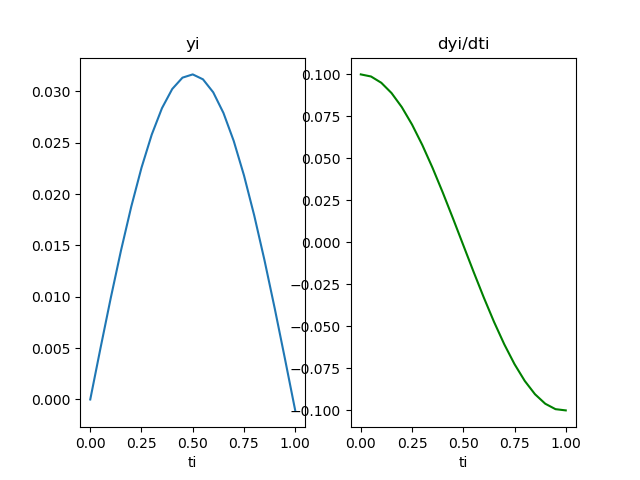Ejercicio: 2Eva_IT2010_T2 Movimiento angular
Para resolver, se usa Runge-Kutta_fg de segundo orden como ejemplo
y'' + 10 \sin (y) =0se hace
y' = z = f(t,y,z)y se estandariza:
y'' =z'= -10 \sin (y) = g(t,y,z)teniendo como punto de partida t0=0, y0=0 y z0=0.1
y(0)=0, y'(0)=0.1Se desarrolla el algotitmo para obtener los valores:
[ t, y, dyi/dti=z] [[ 0. 0. 0.1 ] [ 0.2 0.02 0.08000133] [ 0.4 0.03200053 0.02401018] [ 0.6 0.03040355 -0.04477916] [ 0.8 0.01536795 -0.09662411] [ 1. -0.00703034 -0.10803459]]
que permiten generar la gráfica de respuesta:
Algoritmo en Python
# 2Eva_IT2010_T2 Movimiento angular import numpy as np import matplotlib.pyplot as plt def rungekutta2_fg(f,g,x0,y0,z0,h,muestras): tamano = muestras + 1 estimado = np.zeros(shape=(tamano,3),dtype=float) # incluye el punto [x0,y0,z0] estimado[0] = [x0,y0,z0] xi = x0 yi = y0 zi = z0 for i in range(1,tamano,1): K1y = h * f(xi,yi,zi) K1z = h * g(xi,yi,zi) K2y = h * f(xi+h, yi + K1y, zi + K1z) K2z = h * g(xi+h, yi + K1y, zi + K1z) yi = yi + (K1y+K2y)/2 zi = zi + (K1z+K2z)/2 xi = xi + h estimado[i] = [xi,yi,zi] return(estimado) # INGRESO theta = y ft = lambda t,y,z: z gt = lambda t,y,z: -10*np.sin(y) t0 = 0 y0 = 0 z0 = 0.1 h=0.2 muestras = 5 # PROCEDIMIENTO tabla = rungekutta2_fg(ft,gt,t0,y0,z0,h,muestras) # SALIDA print(' [ t, \t\t y, \t dyi/dti=z]') print(tabla) # Grafica ti = np.copy(tabla[:,0]) yi = np.copy(tabla[:,1]) zi = np.copy(tabla[:,2]) plt.subplot(121) plt.plot(ti,yi) plt.xlabel('ti') plt.title('yi') plt.subplot(122) plt.plot(ti,zi, color='green') plt.xlabel('ti') plt.title('dyi/dti') plt.show()

